SEO
Which Is Right For You?

When you run a business globally, your website is one of the most powerful tools to reach and communicate with your target audience.
If you are conducting business offline in various countries, you already know how different the audience is from country to country.
Each country also has different business-related policies and rules. With a website, you also need to consider these and online regulations.
From an international SEO viewpoint, there are some critical aspects that the site owners must always keep in mind, including geotargeting, different search engines, and differences between each local audience.
There are additional factors to consider when deciding to have a global site or separate local sites – a place for each targeting country or language – including maintenance costs and the availability of local teams to maintain the sites.
In this article, I will explain four areas that greatly determine whether a global or local site is better for you.
Data & Privacy-Related Laws & Regulations
It is impossible to list all laws and regulations to do business in different countries around the globe. But two of the most important sets of laws and regulations for website owners to pay attention to are:
As mentioned above, each region, country, or state can set its own, and it can be a broad policy, guidance, law, or any other type of regulation.
Some are applied to all websites, while others are applied to websites for specific scopes, such as government and public sectors.
In the European Union (EU)
The EU’s General Data Protection Regulation (GDPR) is probably the most talked about privacy and data protection regulation.
It regulates the processing by an individual, a company, or an organization of personal data relating to individuals in the EU.
In California
The State of California has passed the California Consumer Privacy Act (CCPA), and many companies expect other states to follow suit and enact similar privacy laws shortly.
Some sites have already responded by showing the cookie consent message to everyone regardless of the access location.
In Japan
The Act on the Protection of Personal Information was first set up in 2005 in Japan, drastically amended in 2016, and has been in full force since 2017. It mandates Japanese websites to post a privacy policy and other requirements.
Ecommerce sites must also post the information specified in the Commercial Transactions Law.
Even if the website is managed in the U.S., your Japanese website must meet these regulations, especially if you have a physical presence in Japan.
 Apple Inc. U.K. Website Footer
Apple Inc. U.K. Website Footer Apple Inc. Japanese Website Footer
Apple Inc. Japanese Website Footer Screenshot of Apple Inc. Chinese Website Footer, September 2022
Screenshot of Apple Inc. Chinese Website Footer, September 2022The above images are from the footer on Apple’s websites in the U.S., U.K., Japan, and China.
In addition to a standard privacy policy, the U.K. site has a page about using cookies about GDPR.
The Chinese website indicates the website registration number below the footer links as required by Chinese regulations.
Accessibility-Related Laws & Regulations
Last month, the Americans with Disabilities Act (ADA) made headlines when a federal lawsuit against Taco Bell was filed. While it was against the restaurant, this got many website owners’ attention.
Currently, there are IT accessibility laws and policies for U.S. federal agencies and several guidelines and standards to be considered in general, including the Information and Communication Technology Standards and Guidelines.
ADA applies to both public and private sectors, including websites. In terms of website accessibility, many points will improve overall user experiences for not just people with disabilities but all website users.
For many countries and regions, including Canada, China, the EU, Japan, and the U.K., accessibility to web content is often a mandatory policy.
W3C has an excellent overview and country-specific information on web accessibility laws and policies.
Like the data and privacy laws and regulations, each country has different requirements for accessibility.
It’s a growing task for website owners to keep up with these rapidly changing requirements, especially for global site owners. Failure to adhere to them can be costly financially and negatively impact brand image.
Local Trends & Competitors
I work closely with websites targeting the Asian market, so I can usually tell if the site is a local company site or a global company’s local site from the design and content.
The difference is not caused by the design skill but by how much they understand the local market and the target audience.
The easiest way to show this difference is to compare the website’s design. The layout, color scheme, and images are also other telltale signs of where the site was created.
For eCommerce sites, how people expect to pay for the orders differs from country to country. The exchange and return policy are another difference among countries.
While these differences don’t impact the entire site, they can cause customers to abandon the shopping cart.
The differences in the local interests are reflected in website content, too. Often, global sites’ content is determined by the HQ country, while local competitor websites have content designed to satisfy the specific interests of the local audiences.
The inability to satisfy the local searcher’s intent can cause a considerable business opportunity loss to the global website.
As Google improves the algorithms to present the best content for each searcher, poorly localized content that is not particularly written for local audiences won’t be competitive in the search results.
 Screenshot from Google U.S. search results for [mug cup], September 2022
Screenshot from Google U.S. search results for [mug cup], September 2022 Screenshot from Google Japan search results for [mug cup], September 2022
Screenshot from Google Japan search results for [mug cup], September 2022(Product images reflecting the local interests: U.S. and Japan “mug cup” Google search results)
One Global Website vs. Multiple Local Websites
If you have global sites under one domain using the same webpage templates for all country websites, create a list of must-meet regulation points from all concerned countries, and implement them regardless of the target country.
While it seems like an enormous task, if you have a smaller team or don’t have a team in each country, this is the best option for you to cover all bases.
In this case, having someone responsible for reviewing and keeping up with laws and regulations would be helpful as these are updated from time to time.
You may want to consider creating a separate website for each target country if you have:
- A good number of team members in each local country manage the website.
- Enough budget to support it.
Even if you separate the sites by regions with similar laws and regulations or user and cultural trends, it would give you more flexibility, be better compliant, and be appropriately designed for local audiences.
For example, instead of setting up multiple country and language sites within the EU under one domain set up for the EU market, it is probably easier to manage the website design and content for a specific audience in each country in the EU.
Central and South American countries may be another target market that works with one domain with multiple country sites.
Considering the multiple characteristics of the Chinese market – from Baidu’s capability and algorithms to connection speed, website registration policy, and cybersecurity law (a.k.a. “Great Firewall of China”), it may make sense to create a separate Chinese website for many companies that consider China as one of their important markets.
When you have a particular website, you can host it in the country to help improve the download speed.
It is easier to obtain ccTLD with the website registered with the Chinese government and provide the content designed specifically for the Chinese audience.
Final Thoughts
Having a separate website for each target country offers many more options and the flexibility to comply with local laws and policies and reflect local interests in the content and website design.
These are also great for geotargeting in SEO, which is one of the biggest concerns for many global website owners. However, it comes with an increased overhead cost.
It is not impossible to meet the local laws and policies with one global domain website.
As Apple and other global corporations do, you can provide unique local content even with different website designs.
Using the same domain doesn’t mean having the same design or using the same CMS. It is possible to have the localized content on the same CMS and add local-only unique content using a different CMS on the same domain site.
When deploying global or local sites, meeting local regulations and accommodating local audiences’ interests are essential.
Once you set up websites, track the performance data from each local site and content and make adjustments as needed.
Suppose the data indicates that having a global site limits the business potential due to different local interests and requirements or that having local sites is too costly. In that case, you need to reconsider the options.
More Resources:
Featured Image: AOME1812/Shutterstock
SEO
Measuring Content Impact Across The Customer Journey

Understanding the impact of your content at every touchpoint of the customer journey is essential – but that’s easier said than done. From attracting potential leads to nurturing them into loyal customers, there are many touchpoints to look into.
So how do you identify and take advantage of these opportunities for growth?
Watch this on-demand webinar and learn a comprehensive approach for measuring the value of your content initiatives, so you can optimize resource allocation for maximum impact.
You’ll learn:
- Fresh methods for measuring your content’s impact.
- Fascinating insights using first-touch attribution, and how it differs from the usual last-touch perspective.
- Ways to persuade decision-makers to invest in more content by showcasing its value convincingly.
With Bill Franklin and Oliver Tani of DAC Group, we unravel the nuances of attribution modeling, emphasizing the significance of layering first-touch and last-touch attribution within your measurement strategy.
Check out these insights to help you craft compelling content tailored to each stage, using an approach rooted in first-hand experience to ensure your content resonates.
Whether you’re a seasoned marketer or new to content measurement, this webinar promises valuable insights and actionable tactics to elevate your SEO game and optimize your content initiatives for success.
View the slides below or check out the full webinar for all the details.
SEO
How to Find and Use Competitor Keywords

Competitor keywords are the keywords your rivals rank for in Google’s search results. They may rank organically or pay for Google Ads to rank in the paid results.
Knowing your competitors’ keywords is the easiest form of keyword research. If your competitors rank for or target particular keywords, it might be worth it for you to target them, too.
There is no way to see your competitors’ keywords without a tool like Ahrefs, which has a database of keywords and the sites that rank for them. As far as we know, Ahrefs has the biggest database of these keywords.
How to find all the keywords your competitor ranks for
- Go to Ahrefs’ Site Explorer
- Enter your competitor’s domain
- Go to the Organic keywords report
The report is sorted by traffic to show you the keywords sending your competitor the most visits. For example, Mailchimp gets most of its organic traffic from the keyword “mailchimp.”


Since you’re unlikely to rank for your competitor’s brand, you might want to exclude branded keywords from the report. You can do this by adding a Keyword > Doesn’t contain filter. In this example, we’ll filter out keywords containing “mailchimp” or any potential misspellings:
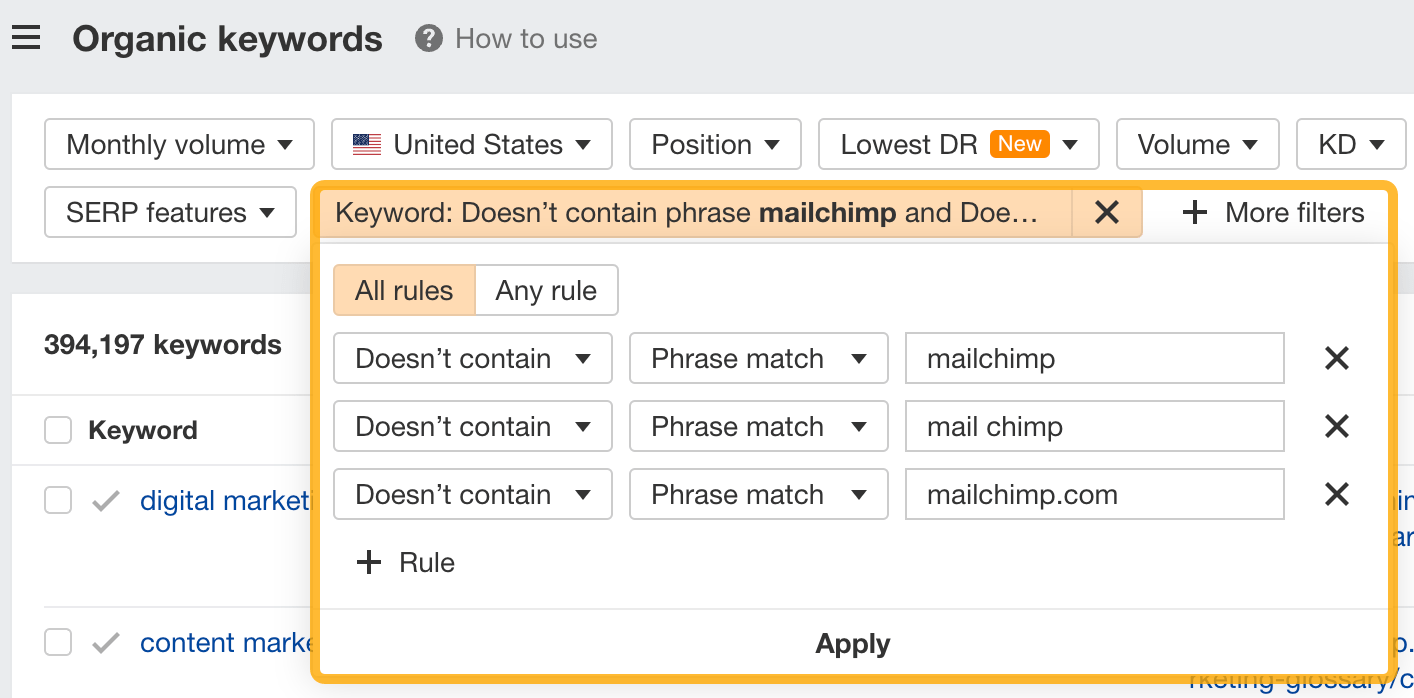

If you’re a new brand competing with one that’s established, you might also want to look for popular low-difficulty keywords. You can do this by setting the Volume filter to a minimum of 500 and the KD filter to a maximum of 10.


How to find keywords your competitor ranks for, but you don’t
- Go to Competitive Analysis
- Enter your domain in the This target doesn’t rank for section
- Enter your competitor’s domain in the But these competitors do section


Hit “Show keyword opportunities,” and you’ll see all the keywords your competitor ranks for, but you don’t.


You can also add a Volume and KD filter to find popular, low-difficulty keywords in this report.


How to find keywords multiple competitors rank for, but you don’t
- Go to Competitive Analysis
- Enter your domain in the This target doesn’t rank for section
- Enter the domains of multiple competitors in the But these competitors do section
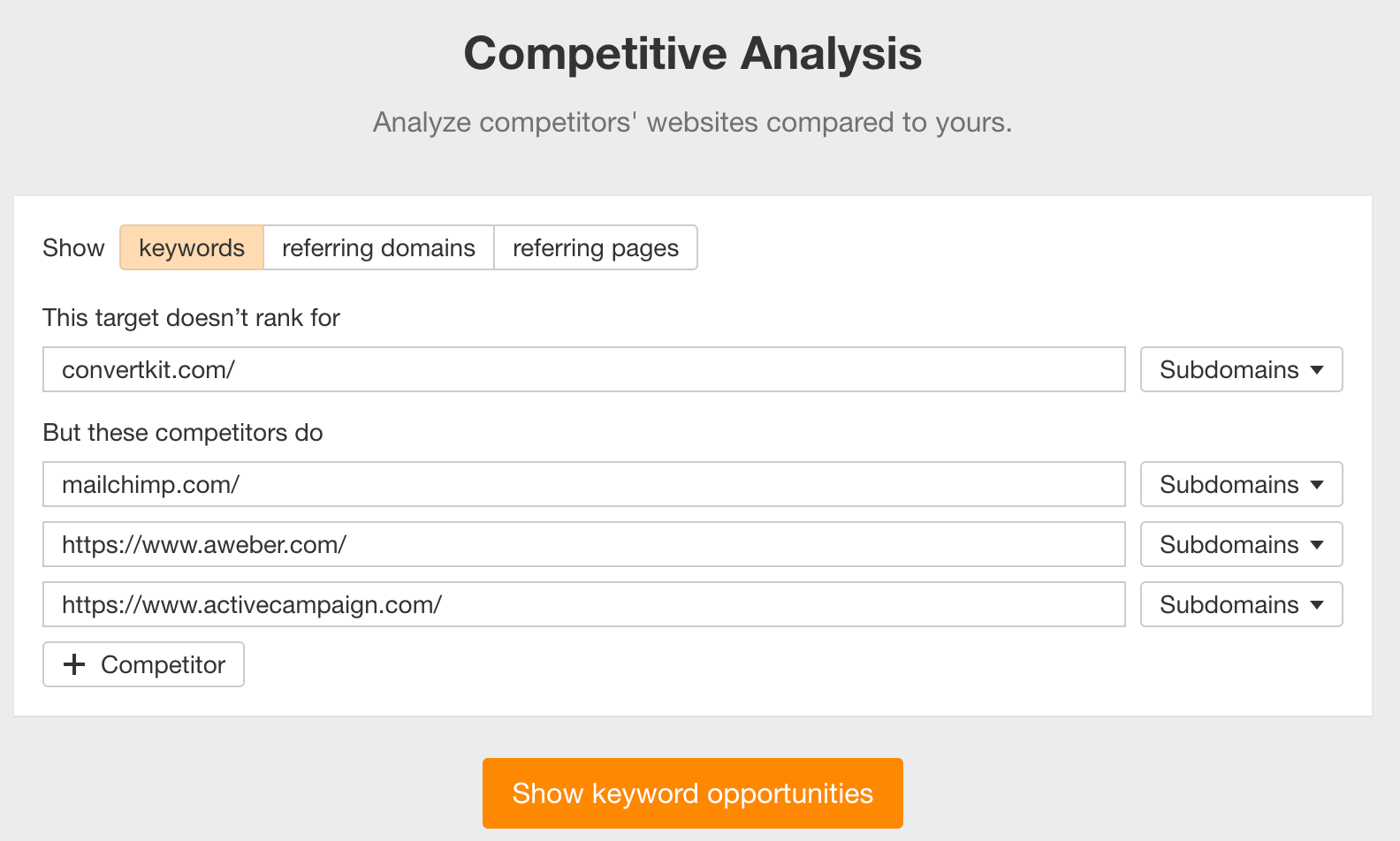

You’ll see all the keywords that at least one of these competitors ranks for, but you don’t.


You can also narrow the list down to keywords that all competitors rank for. Click on the Competitors’ positions filter and choose All 3 competitors:


- Go to Ahrefs’ Site Explorer
- Enter your competitor’s domain
- Go to the Paid keywords report
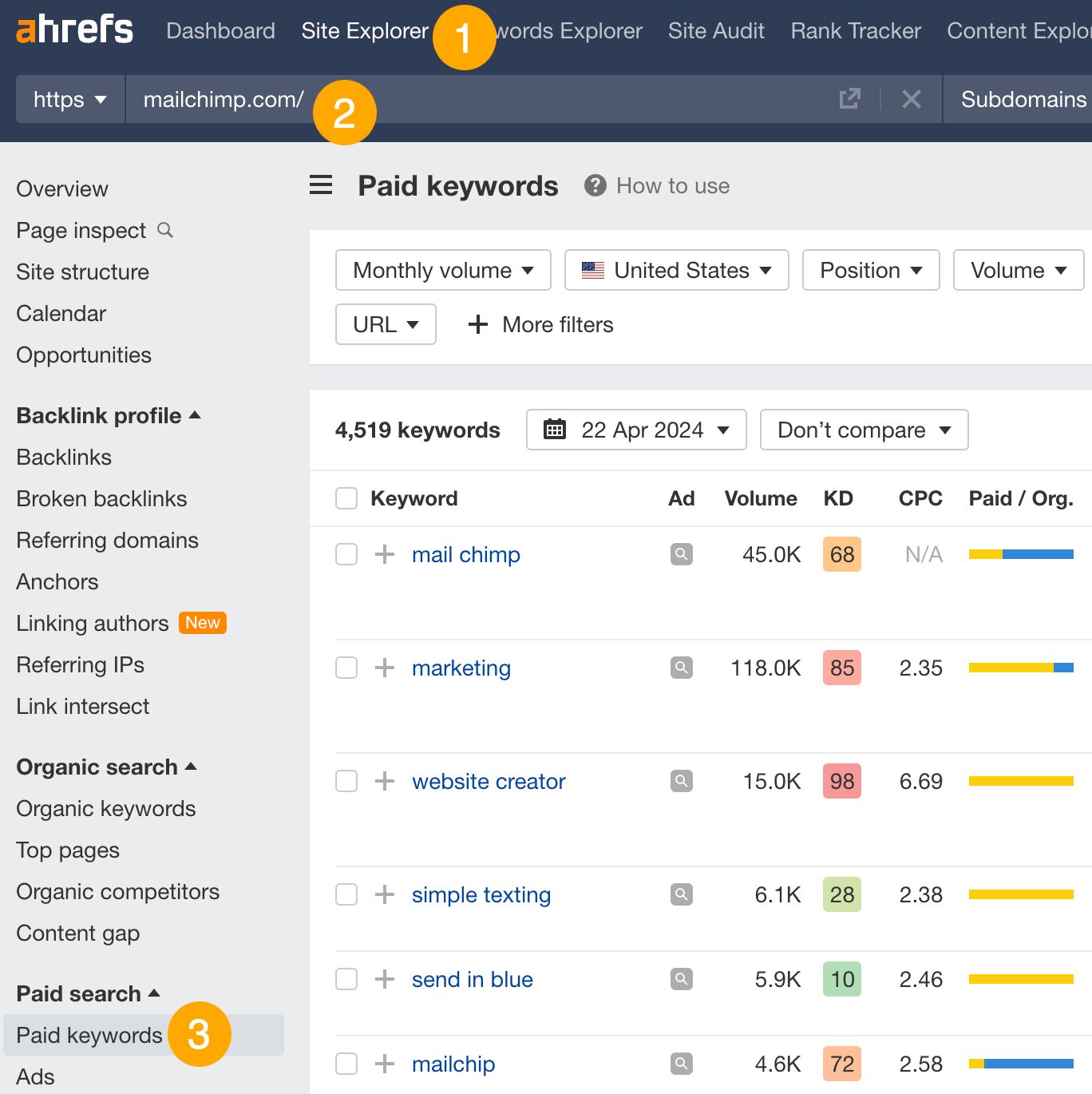

This report shows you the keywords your competitors are targeting via Google Ads.
Since your competitor is paying for traffic from these keywords, it may indicate that they’re profitable for them—and could be for you, too.
You know what keywords your competitors are ranking for or bidding on. But what do you do with them? There are basically three options.
1. Create pages to target these keywords
You can only rank for keywords if you have content about them. So, the most straightforward thing you can do for competitors’ keywords you want to rank for is to create pages to target them.
However, before you do this, it’s worth clustering your competitor’s keywords by Parent Topic. This will group keywords that mean the same or similar things so you can target them all with one page.
Here’s how to do that:
- Export your competitor’s keywords, either from the Organic Keywords or Content Gap report
- Paste them into Keywords Explorer
- Click the “Clusters by Parent Topic” tab


For example, MailChimp ranks for keywords like “what is digital marketing” and “digital marketing definition.” These and many others get clustered under the Parent Topic of “digital marketing” because people searching for them are all looking for the same thing: a definition of digital marketing. You only need to create one page to potentially rank for all these keywords.
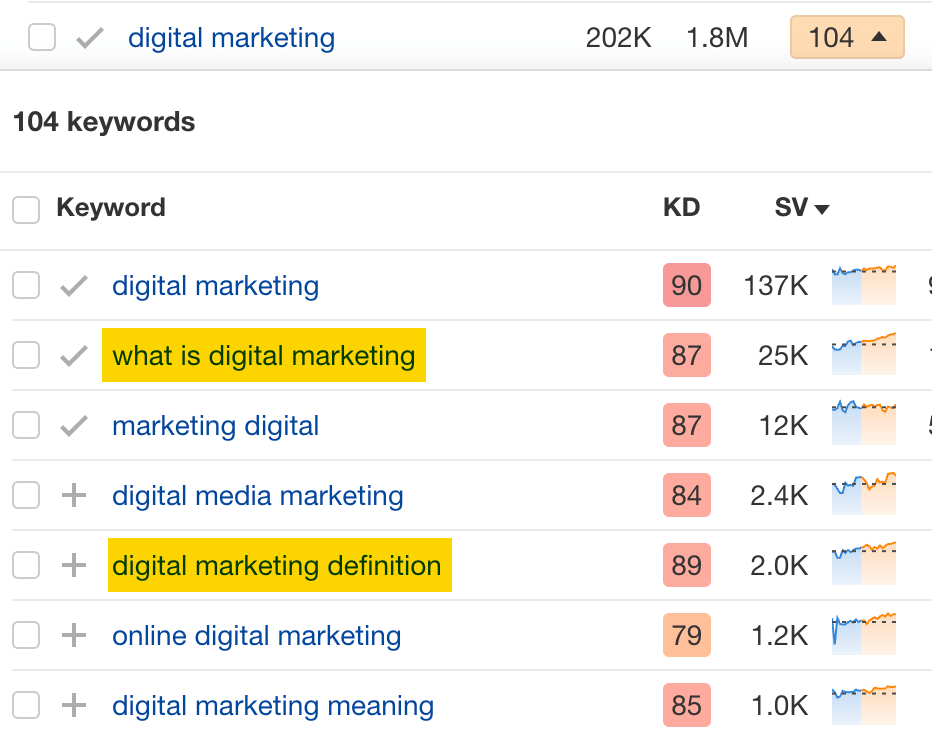

2. Optimize existing content by filling subtopics
You don’t always need to create new content to rank for competitors’ keywords. Sometimes, you can optimize the content you already have to rank for them.
How do you know which keywords you can do this for? Try this:
- Export your competitor’s keywords
- Paste them into Keywords Explorer
- Click the “Clusters by Parent Topic” tab
- Look for Parent Topics you already have content about
For example, if we analyze our competitor, we can see that seven keywords they rank for fall under the Parent Topic of “press release template.”


If we search our site, we see that we already have a page about this topic.


If we click the caret and check the keywords in the cluster, we see keywords like “press release example” and “press release format.”
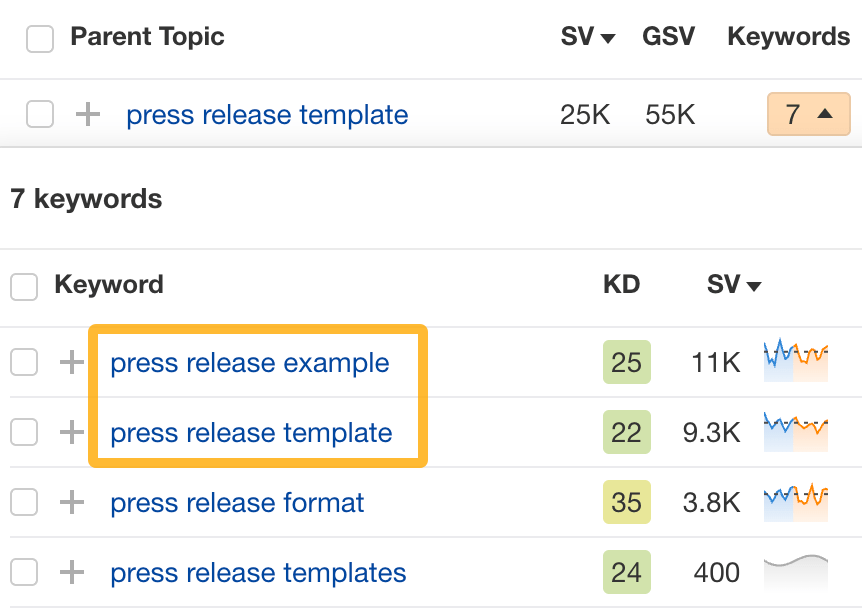

To rank for the keywords in the cluster, we can probably optimize the page we already have by adding sections about the subtopics of “press release examples” and “press release format.”
3. Target these keywords with Google Ads
Paid keywords are the simplest—look through the report and see if there are any relevant keywords you might want to target, too.
For example, Mailchimp is bidding for the keyword “how to create a newsletter.”


If you’re ConvertKit, you may also want to target this keyword since it’s relevant.
If you decide to target the same keyword via Google Ads, you can hover over the magnifying glass to see the ads your competitor is using.
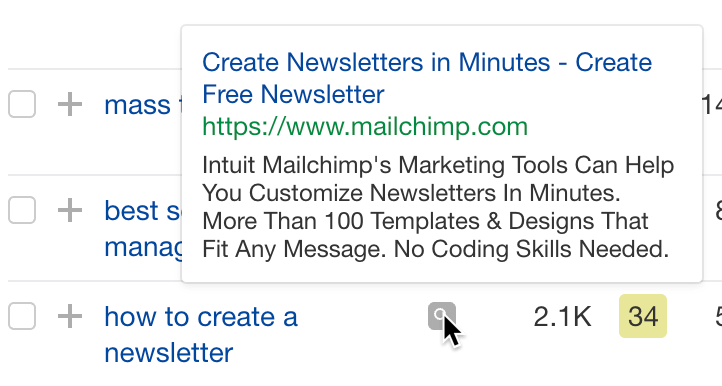

You can also see the landing page your competitor directs ad traffic to under the URL column.


Learn more
Check out more tutorials on how to do competitor keyword analysis:
SEO
Google Confirms Links Are Not That Important

Google’s Gary Illyes confirmed at a recent search marketing conference that Google needs very few links, adding to the growing body of evidence that publishers need to focus on other factors. Gary tweeted confirmation that he indeed say those words.
Background Of Links For Ranking
Links were discovered in the late 1990’s to be a good signal for search engines to use for validating how authoritative a website is and then Google discovered soon after that anchor text could be used to provide semantic signals about what a webpage was about.
One of the most important research papers was Authoritative Sources in a Hyperlinked Environment by Jon M. Kleinberg, published around 1998 (link to research paper at the end of the article). The main discovery of this research paper is that there is too many web pages and there was no objective way to filter search results for quality in order to rank web pages for a subjective idea of relevance.
The author of the research paper discovered that links could be used as an objective filter for authoritativeness.
Kleinberg wrote:
“To provide effective search methods under these conditions, one needs a way to filter, from among a huge collection of relevant pages, a small set of the most “authoritative” or ‘definitive’ ones.”
This is the most influential research paper on links because it kick-started more research on ways to use links beyond as an authority metric but as a subjective metric for relevance.
Objective is something factual. Subjective is something that’s closer to an opinion. The founders of Google discovered how to use the subjective opinions of the Internet as a relevance metric for what to rank in the search results.
What Larry Page and Sergey Brin discovered and shared in their research paper (The Anatomy of a Large-Scale Hypertextual Web Search Engine – link at end of this article) was that it was possible to harness the power of anchor text to determine the subjective opinion of relevance from actual humans. It was essentially crowdsourcing the opinions of millions of website expressed through the link structure between each webpage.
What Did Gary Illyes Say About Links In 2024?
At a recent search conference in Bulgaria, Google’s Gary Illyes made a comment about how Google doesn’t really need that many links and how Google has made links less important.
Patrick Stox tweeted about what he heard at the search conference:
” ‘We need very few links to rank pages… Over the years we’ve made links less important.’ @methode #serpconf2024″
Google’s Gary Illyes tweeted a confirmation of that statement:
“I shouldn’t have said that… I definitely shouldn’t have said that”
Why Links Matter Less
The initial state of anchor text when Google first used links for ranking purposes was absolutely non-spammy, which is why it was so useful. Hyperlinks were primarily used as a way to send traffic from one website to another website.
But by 2004 or 2005 Google was using statistical analysis to detect manipulated links, then around 2004 “powered-by” links in website footers stopped passing anchor text value, and by 2006 links close to the words “advertising” stopped passing link value, links from directories stopped passing ranking value and by 2012 Google deployed a massive link algorithm called Penguin that destroyed the rankings of likely millions of websites, many of which were using guest posting.
The link signal eventually became so bad that Google decided in 2019 to selectively use nofollow links for ranking purposes. Google’s Gary Illyes confirmed that the change to nofollow was made because of the link signal.
Google Explicitly Confirms That Links Matter Less
In 2023 Google’s Gary Illyes shared at a PubCon Austin that links were not even in the top 3 of ranking factors. Then in March 2024, coinciding with the March 2024 Core Algorithm Update, Google updated their spam policies documentation to downplay the importance of links for ranking purposes.
The documentation previously said:
“Google uses links as an important factor in determining the relevancy of web pages.”
The update to the documentation that mentioned links was updated to remove the word important.
Links are not just listed as just another factor:
“Google uses links as a factor in determining the relevancy of web pages.”
At the beginning of April Google’s John Mueller advised that there are more useful SEO activities to engage on than links.
Mueller explained:
“There are more important things for websites nowadays, and over-focusing on links will often result in you wasting your time doing things that don’t make your website better overall”
Finally, Gary Illyes explicitly said that Google needs very few links to rank webpages and confirmed it.
I shouldn’t have said that… I definitely shouldn’t have said that
— Gary 鯨理/경리 Illyes (so official, trust me) (@methode) April 19, 2024
Why Google Doesn’t Need Links
The reason why Google doesn’t need many links is likely because of the extent of AI and natural language undertanding that Google uses in their algorithms. Google must be highly confident in its algorithm to be able to explicitly say that they don’t need it.
Way back when Google implemented the nofollow into the algorithm there were many link builders who sold comment spam links who continued to lie that comment spam still worked. As someone who started link building at the very beginning of modern SEO (I was the moderator of the link building forum at the #1 SEO forum of that time), I can say with confidence that links have stopped playing much of a role in rankings beginning several years ago, which is why I stopped about five or six years ago.
Read the research papers
Authoritative Sources in a Hyperlinked Environment – Jon M. Kleinberg (PDF)
The Anatomy of a Large-Scale Hypertextual Web Search Engine
Featured Image by Shutterstock/RYO Alexandre
-

 PPC4 days ago
PPC4 days ago19 Best SEO Tools in 2024 (For Every Use Case)
-

 MARKETING7 days ago
MARKETING7 days agoWill Google Buy HubSpot? | Content Marketing Institute
-
SEARCHENGINES7 days ago
Daily Search Forum Recap: April 16, 2024
-

 SEO7 days ago
SEO7 days agoGoogle Clarifies Vacation Rental Structured Data
-

 MARKETING6 days ago
MARKETING6 days agoStreamlining Processes for Increased Efficiency and Results
-
SEARCHENGINES6 days ago
Daily Search Forum Recap: April 17, 2024
-

 SEO6 days ago
SEO6 days agoAn In-Depth Guide And Best Practices For Mobile SEO
-

 PPC6 days ago
PPC6 days ago97 Marvelous May Content Ideas for Blog Posts, Videos, & More















You must be logged in to post a comment Login